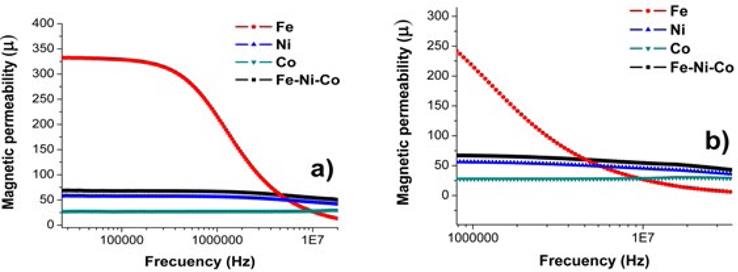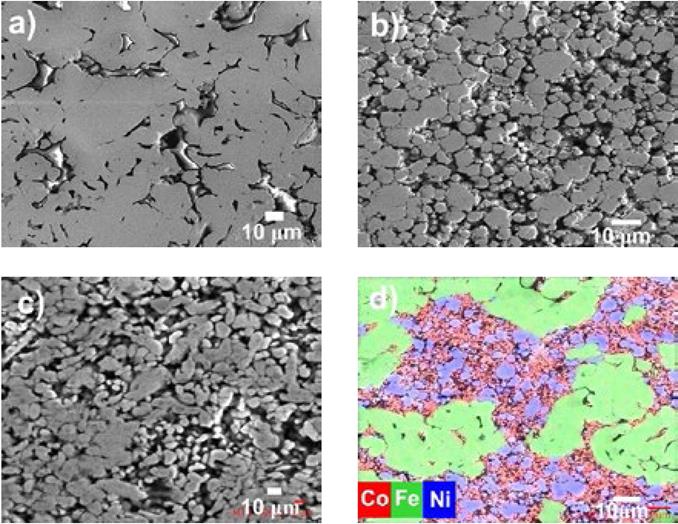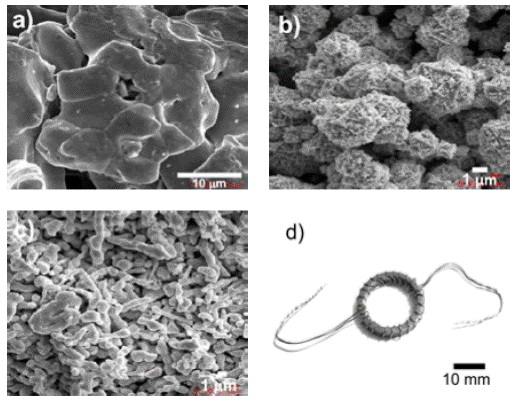Introduction
Magnetic materials are useful in developing new technologies; they are divided into two groups, the hard magnetic and soft magnetic ones. The latter have great applications in the electrical, electronic, computing, telecommunications and even in the metalworking industries, thanks to the ability to be magnetized and demagnetized when a magnetic field passes through them [1]. The main characteristics that these materials possess are: high magnetic permeability, high saturation and low coercive field. These materials can work with alternating current (AC) and direct current (DC). The first materials used were silicon steels and soft ferrites having good properties, but they are limited in shapes and sizes for useful applications. In recent decades, iron-based composites have been developed in order to use them as soft magnetic materials and most of them have had great success overpassing the properties of silicon steels and ferrites [1]. The fabrication of these materials consist in including magnetic powder of pure Fe or Fe-based alloys with Ni, Co, P, Nd, B, Mn, Zn and Ba in a polymeric matrix [2, 3]. The magnetic permeability, hysteresis and electric resistivity properties have been evaluated in many studies, and a detailed review has been reported by Shokrollahi and Janghorban [4]. Some studies involving effects such as compaction pressure [5], sintering temperature [6], annealing process [7], polymer content [8] and grain size [9] have been carried out in order to determine the working ranges to perform specific applications. The study of the mixing process of the phases in the composites has shown to be important in order to obtain a better distribution of the magnetic powder into the polymer [10, 11]. However, the use of the primary mixtures with powders of Fe, Co and Ni, has not been widely studied, even though they could give satisfactory properties with low processing cost, which is one of the advantages that these composites could present when compared to the ferrites and silicon steels. Finally, in this work, the magnetic permeability at high frequencies and the hysteresis loop behaviour of Fe-polymer, Ni-polymer, Co-polymer and Fe-Co-Ni-polymer composites have been analysed.
Experimental procedure
Fig. 1a-c shows the starting materials used in this work, these are commercial powder of Fe, Ni and Co, having purities of 99.9%, with particle sizes of 150, 10 and 2 mm, respectively. The polymeric matrix was an epoxy araldite resin. The use of such large size of the iron powder was due to the fact that smaller sizes tend to generate higher coercivity, this being associated with the high number of walls between powders [2]. Small size particles of Ni and Co were added in order to fill the spaces left by the Fe particles when the three metallic elements were mixed together. The composites were prepared by weighting the powders as a function of volume fraction of each element. The resin was obtained by mixing 63.2 wt. % araldite -EPN 1139 novolac liquidand 36.8 wt. % hardener (amino aliphatic HY837). Four different composites were obtained, three of them consisted in preparing samples containing only one of each element with the resin, and the fourth one was a mixture of the three metallic elements. Table 1 presents the composition of the experimentally prepared metallic based composites. Once the resin was ready, the powders were added to it. The materials were, then, mixed with 2 ml of acetone using an ultrasonic pencil with frequency of 20 kHz during 5 minutes; the aim of this stage of the experimentation was to obtain a homogeneous distribution of the phases in the material. Each mixture was settled at room temperature until the acetone evaporated. The resin-powder mixture was then poured into a steel compaction die to obtain pieces with a ringshaped geometry, with 20 mm external and 17.5 mm internal diameters, respectively. The composites were prepared by uniaxial compaction, applying a pressure of 91 MPa. The resulting samples were settled for at least 9 hours at room temperature in order to cure the resin. The magnetic permeability was measured with a precision impedance analyzer, model 294, with a capacity range from 40 Hz to 110 MHz. The samples were prepared by winding copper wire around of the rings, which were previously produced, obtaining a toroid sample (Fig. 1d). The hysteresis loops were analysed with a vibrating sample magnetometer Ldj Electronics model 9600. The metallic powders and the particle distribution of the composites were observed by means of a Scanning Electron Microscope JEOL JSM-6400.
Results and discussion
Magnetic properties
Fig. 2 shows the magnetic permeability values of the Fe-, Niand Coand the Fe-Ni-Co-polymer matrix composites. It is observed in the curves that the Fe-polymer composite showed the highest magnetic permeability of all the composites for frequencies lower than 1.5x106 Hz. However, as the frequency increases, its magnetic permeability decreases, this behaviour was found to be much higher for the rest of the Fe-Ni-Co-, Niand Co-polymer composites, following this order. On the other hand, at a frequency starting at 1.2x107 Hz the magnetic permeability, μ, of the Fe-polymer, Co-polymer and Ni-polymer composites (26, 28.5, 45.5, respectively) were lower than that of the Fe-Ni-Co-polymer (μ=54) composite. Fig. 2b) shows in more detail this behaviour. These results indicate that the magnetic permeability of the powder-polymer composites is governed by the metallic powers volume fraction, since Ni and Co occupy 60 vol. %, meanwhile the volume occupied by the Fe is 27%, and the rest was attributed to the resin and residual porosity. As can be seen, a small increment in the magnetic permeability is due to the contribution of Fe. Nevertheless, it is worth mentioning that the addition of Fe powders allows obtaining low cost materials when compared to the Niand Copolymer composites.

Fig. 2 Magnetic permeability evolution as a function of the AC frequency of the magnetic field, (a) All the composites and (b) close up from 1x106 to 1x108 Hz.
Fig. 3 shows the hysteresis loops obtained from the Fe-, Ni-, Coand Fe-Ni-Co-polymer composites. It is observed that the magnetization of saturation, Ms, is higher for the Fe-, followed by Coand finally by Ni-polymer composites (16000, 11000 and 4100 Am2Kg-1, respectively). The Ms of the Fe-NiCo composite (10000 Am2Kg-1) is higher than that of the Ni-, but lower than those for Feand Copolymer composites. Fig. 3b) presents a magnification of the hysteresis loops of Fig. 3a), it can be seen that the contribution of Fe did help to decrease the coercive force, Hc, reducing the width of the curve when compared to those for the Co-polymer and Ni-polymer (801 and 400 Am-1, respectively), although the width of the curve which corresponds to the Fepolymer composite (Hc=336 Am-1) is still thinner than that for the Fe-Ni-Co-polymer composite (Hc=408 Am-1). The coercive force of the Fe-Ni-Copolymer and Ni-polymer composites are closed.
Microstructure characterization
The internal microstructure of the composites was observed in a scanning electron microscope (SEM). Fig. 4a) shows that in the Fe-polymer composite, the metallic powders leave a wide porosity between them; this was attributed to its large size. This porosity was also observed in the Niand Cocomposites (Fig. 4b) c). Apparently, there is a high fraction of porosity, but with a small pore size. This can be explain in terms of the small particle size of the powders used in this work. Fig. 4d) shows that the Fe-Ni-Co-polymer composite presents a well metallic particle distribution, this is due to the small Ni particles were accommodated into the big holes left by the Fe particles, meanwhile de Co particles were accommodated into the pores left by the Fe and Ni particles, reducing the porosity of the material, when compared to the porosities obtained in the composites containing only one metallic element.

Fig. 4 Photomicrographs of the composites internal microstructures, (a) Fe-polymer, (b) Ni-polymer, (c) Co-polymer and (d) Fe-Ni-Co-polymer.
It can also be assumed that the distribution of the polymer in the composite was rather homogeneous, this reduced the Eddy current loses by covering all metallic powders, i.e. isolating each of them. The magnetic behavior of the Fe-Ni-Copolymer composite when it is compared to the individual metal-polymer composites allowed observing an important influence of the volume fraction of the components. This can be accentuated by the particle size of both Ni and Co in the material, due to a higher number of mini magnetic domains generated by each particle in the interior of the material. This response is attributed to the nature of the metallic powder, i.e. highly pure elements were used instead of its corresponding alloys.
The magnetization and magnetic permeability values obtained for the Fe-Ni-Co-polymer composite are in the range of the materials that work at high frequencies. This property is used in the industry of heat treatments by induction heating; as for some applications, it is necessary to harden the surface of steels without sacrificing the ductility.
Conclusions
A well distribution of metallic particles was achieved in the FeNi-Co-polymer, mainly because of the difference on particle sizes, which allowed the small particles to be accommodated in the empty spaces left by the bigger ones. The magnetic behaviour of the Fe-Ni-Co-polymer composite was close to the Ni-polymer composite. And at high frequencies, the magnetic permeability of the Fe-Ni-Co-polymer was slightly higher than the individual metallic-polymer composites. The coercivity presented by the Niand Co-polymer composites was reduced with the inclusion of Fe, and the magnetization Ms was 40% lower to that of the Fe-polymer composite, which is the composite with the highest value. The rule of mixture cannot be used to estimate the magnetic property values when different particle sizes are used, since the influence of each particle affects the magnetization of the material when it is submitted to an AC magnetic field.











 text new page (beta)
text new page (beta)





